PROPOSED HYDROELECTRIC PROJECT
La Merced de Jondachi (18.1 MW)
The government-owned thermal electric generating company “CELEC EP – Termopichincha”, which has never developed and operated a hydro project, proposes building the 18.1-MW “La Merced de Jondachi” hydroelectric project to offset the carbon emissions from its 20 motor-driven thermal power plants, which use fossil fuels to generate electricity.
However, none of CELEC EP – Termopichincha’s 20 thermal generating power plants are located near the Jondachi River, or in the Napo Province, and their proposed hydroelectric project will eliminate a sustainable tourism-based economy from kayaking the Jondachi River valued at over USD $ 1 million dollars a year.
In Ecuador, thermal power plants are often used to compensate for the variable production of poorly-designed hydroelectric projects whose electric generation is dependent on the available natural flow of water in the rivers, which comes from rainfall.
“CELEC EP – Termopichincha” has applied to receive “carbon credits” through the Kyoto Protocol’s Clean Development Mechanism, sponsored by the United Nations UNFCCC commission.
So far, the La Merced de Jondachi hydroelectric project has not been approved to receive carbon credits by the UNFCCC. However, since “CELEC EP – Termopichincha” generates thermal electricity to compensate for deficits in hydroelectric generation, it stands to gain whether or not the “La Merced de Jondachi” hydroelectric project delivers the promised benefits. In fact, since thermal electricity has a higher market price than hydroelectricity, it may just be part of their business strategy.
Overview / Project Description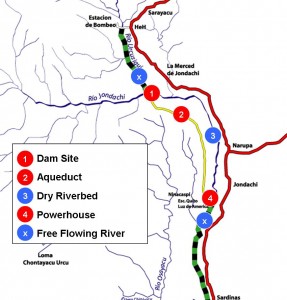
The proposed “La Merced de Jondachi” hydroelectric project is a “run-of-river” hydro project which would build a river-wide dam across the Upper Jondachi River to divert most of its available natural flow into an aqueduct that transports the water downstream to a powerhouse where the water is funneled through up to 2 turbines, which spin large magnets to generate electricity. After passing through the turbines, the water would flow out of the powerhouse through a spillway and be dumped back into the Jondachi River.
Most of the legendary Upper Jondachi River with world-class rapids between the diversion dam and the powerhouse would be effectively de-watered and eliminated as a paddling destination, and an important free-flowing river corridor which provides ecological connectivity between a critical transition zone between the Andes and the Amazon, would be permanently interrupted.
Project Components
Available Natural Flow
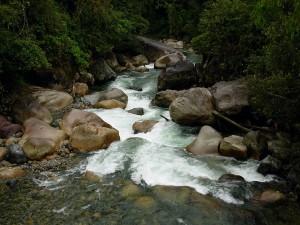
According to the estimations made by the project developer, 90% of the time (Q90%), the Jondachi River maintains a flow of at least 230 cfs* at the dam site.
No hydrologic data exists for the Jondachi River.
*CFS = Cubic Feet per Second (volume of water in cubic feet, passing by a given point in the river in 1 second)
River-wide Diversion Dam
The proposed project would build a 4-meter-tall, river-wide dam across the Jondachi River, to divert 469 cfs away from the river, which is the amount of water required to operate the hydroelectric project at full capacity and generate 18.1 MW of electricity.
The impoundment of water behind this small diversion dam would not be big enough to provide any meaningful water storage. The dam would not be able to capture and hold excess water when high flows occur after heavy rains, and would have no water reserve to draw from during low-flow periods to maintain stable electricity generation.
Since CELEC EP – Termopichincha’s own studies show the Jondachi River maintains a 90% probable daily flow of only 230 cfs, it remains unclear how the project will deliver the benefits that it promises.
Instream Environmental Flow
The Ecuadorian constitution mandates the prioritization of instream environmental flows above productive uses, and Ecuadorian regulations require hydroelectric projects to consider recreational uses (among other criteria) in environmental flow determinations.
Despite ongoing efforts by the ERI to ensure that recreational use of the Jondachi River is considered by the project developer and the government authorities, no considerations have been made.
According to CELEC EP – Termopichincha’s water permit, the project is required to leave only 56 cfs in the affected section of river between the diversion dam and the powerhouse. However, in their application for carbon credits to the UNFCCC clean development mechanism, CELEC EP – Termopichincha stated that they would leave a minimum environmental flow of 77 cfs in the affected section of river between the diversion dam and the powerhouse.
Meanwhile, experienced whitewater kayakers estimate the minimum acceptable flow for paddling the Upper Jondachi to be at least 200 cfs.
A flow of 56 – 77 cfs in the affected river section would eliminate whitewater paddling on the Upper Jondachi, and it is questionable whether that minimum flow would even be sufficient to sustain native fish populations and riverside vegetation.
Aqueduct
 The water is proposed to be routed from the diversion dam to the powerhouse through an aqueduct about 4.2-km in length, with the capacity to carry up to 491 cfs.
The water is proposed to be routed from the diversion dam to the powerhouse through an aqueduct about 4.2-km in length, with the capacity to carry up to 491 cfs.
Initially, the aqueduct would begin as a canal 2.5m deep, and 3m wide, but since the terrain is so rugged and unstable along the river, a 3m-diameter tunnel would be bored through the mountain, and then emerge again as a canal until an area above the powerhouse is reached, where the water would be funneled through stainless steel “penstock” tubes running directly to the turbines to generate electricity.
Powerhouse
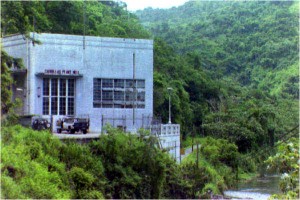 A powerhouse would be constructed next to the Jondachi River, with two Francis turbines installed to generate up to 18.1 MWh of electricity.
A powerhouse would be constructed next to the Jondachi River, with two Francis turbines installed to generate up to 18.1 MWh of electricity.
Each 9.05-MW Francis Turbine would require 234.5 cfs to generate at full capacity, and needs a minimum of 94 cfs to start generating electricity.
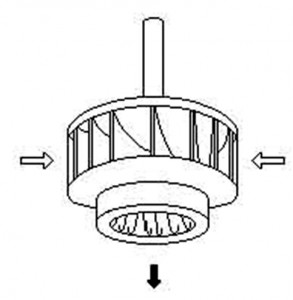
Since CELEC EP – Termopichincha’s own studies show the Jondachi River maintains a 90% probable daily flow of only 230 cfs, and they have promised to maintain 56 – 77 cfs as an instream environmental flow below the dam in the Jondachi River, it remains unclear how the project will deliver the benefits that it promises, if they only have 153 – 174 cfs available 90% of the time, which would only generate up to about 5 MWh of electricity, instead of the 18.1 MWh that they promote the project as producing.
Transmission Line
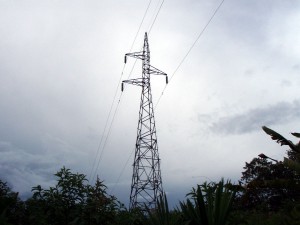 An electrical substation would need to be built next to the powerhouse, along the Jondachi River, where a 138kV power line would make a wide cut through the lush, jungle scenery along its path running from the substation, across the river and out of the river canyon to interconnect the La Merced de Jondachi hydroelectric project to the national electric transmission grid, so that the electricity could be used by population centers far away from the project location.
An electrical substation would need to be built next to the powerhouse, along the Jondachi River, where a 138kV power line would make a wide cut through the lush, jungle scenery along its path running from the substation, across the river and out of the river canyon to interconnect the La Merced de Jondachi hydroelectric project to the national electric transmission grid, so that the electricity could be used by population centers far away from the project location.
Dollars and Sense
The La Merced de Jondachi hydroelectric project has a price tag of USD $39.2 million dollars. CELEC EP – Termopichincha stated in their CDM carbon credit application that they would need to borrow the money to pay the cost of building the project and would pay interest rates of 6.5% on the loan.
The ERI did an economic evaluation of the hydro project based on how the project would perform on an annual basis operating at different available flows of water in the river, using CELEC EP – Termopichincha’s own data and figures, and made the following conclusions:
1 – Considering the continuous, year-round operation of the project, with river flows at the 90% daily probability level of 230 cfs at the dam site, the project would not be able to cover its annual costs, including interest.
2 – If the river maintained 50% probable daily river flows of 446 cfs at the dam site, and the project operated continuously, all year round at that flow, the project could cover its annual costs, including interest, but would only make a cash profit of USD $1.4 MM, which is a mere 3% return on the investment, AND which is less than the 6.5% interest rate CELEC EP – Termopichincha would have to pay on their debt. Meanwhile, the ERI’s recent economic evaluation of kayaking on the Upper Jondachi shows that as a tourism attraction, paddlers using the Upper Jondachi contribute more than USD $1.1 MM of revenues to the local economy each year, which rivals the cash profit which CELEC EP – Termopichincha might hope to take away from the area under the most optimistic conditions.
3 – Based on CELEC EP – Termopichincha’s most recent hydrologic studies, more than 20% of the time the project will not break even on an annual basis, nor would it be able to repay its debt.
4 – Considering the continuous, year-round operation of the project, with river flows at the 50% daily probability level of 446 cfs at the dam site, the project would cost roughly twice Ecuador’s average cost per MWh for hydroelectric projects; at 90% probable daily flows, the project is roughly 4.5x the national average cost per installed Megawatt.
5 – The run-of-river project requires a natural river flow which only has a 34% probability of being observed on a daily basis to operate at its full capacity of 18.1 MWh.
6 – If the flow of the Jondachi River diminished by only 59 cfs below the 90% probable daily flow at the dam site, the project would not have enough available flow to operate with even one turbine, and would not be able to generate electricity. Observed regional climate change trends show a gradual decline in annual precipitation levels corresponding to the decline in natural river flows. Thus, the project would be extremely vulnerable to variations in natural river flow, and would have little capacity to adapt to a changing climate.
Additional information about the La Merced de Jondachi hydroelectric project
Application to UN Clean Development Mechanism for Carbon Credits (English)
Termopichincha website and descriptions (Spanish):
- http://www.termopichincha.com.ec/html/lamerced.html
- http://www.termopichincha.com.ec/index.php/retos-empresariales/proyecto-hidroelectrico-la-merced-de-jondachi
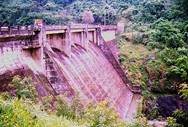
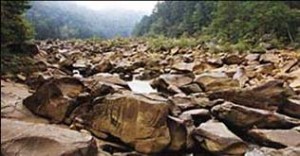

Greetings: How did you perform your economic analysis based on “50% probable daily river flows of 446 cfs” when it’s stated that “No hydrologic data exists for the Jondachi River”? How often are river conditions suitable for kayaking not available? How many Ecuadorians use this river as a recreation corridor? Are there any detrimental environmental concerns, in particular aquatic organisms, that may bolster your opposition to the project other than just human recreation interests?
Hi there, Ben.
Thanks for your interest in our efforts to preserve the Jondachi River as part of a free-flowing Andean Amazon watershed corridor. Here are the responses to your questions:
How did you perform your economic analysis based on “50% probable daily river flows of 446 cfs” when it’s stated that “No hydrologic data exists for the Jondachi River”?
It appears that you mis-interpreted the information. The hydro developer has not installed any weather or stream gauging stations in the Jondachi River and therefore no hydrologic data exists that has been generated directly from the Jondachi River. The hydro developer interpolated historical data of questionable quality and accuracy from another river to generate estimated flow statistics for the Jondachi River which were then used as criteria to design the proposed hydroelectric project. Our economic analysis evaluated the performance and return of the proposed hydro project over all statistic flow ranges. However, in order to cite a relevant flow statistic we referenced what the project performance and return of investment using a 50% probable daily flow, based on the official data presented by the hydro developer.
Here is what was posted on Proposed Hydroelectric Project:
“4- Considering the continuous, year-round operation of the project, with river flows at the 50% daily probability level of 446 cfs at the dam site, the project would cost roughly twice Ecuador’s average cost per MWh for hydroelectric projects; at 90% probable daily flows, the project is roughly 4.5x the national average cost per installed Megawatt.
How often are river conditions suitable for kayaking not available?
The river is paddled year round.
How many Ecuadorians use this river as a recreation corridor?
Thousands of Ecuadorians use the Jondachi River corridor for recreational uses each year. The Jondachi River also draws tourists from around the world who help contribute valuable resources to the local economy.
Are there any detrimental environmental concerns, in particular aquatic organisms, that may bolster your opposition to the project other than just human recreation interests?
The hydro project de-water a significant section of the Jondachi River, it would interrupt the ecological connectivity of the watershed, and would have a detrimental impact to the aquatic ecosystem and native fisheries. The government values economic benefits more than biodiversity.
Please see https://www.youtube.com/watch?v=XnvORJQpp_c&feature=youtu.be
to have a better understanding about the Jondachi River and our criteria and recommendations for prioritizing new hydroelectric development on rivers of low resource quality which are already impacted and intervened, are located close to existing infrastructure and population centers, and which are not renowned ecotourism destinations.
Best regards,
–ERI
Ben Lenz
benlenz1@yahoo.com
32.209.8.8
2016/10/26 at 7:32 am
Proposed Hydroelectric Project
Greetings: How did you perform your economic analysis based on “50% probable daily river flows of 446 cfs” when it’s stated that “No hydrologic data exists for the Jondachi River”? How often are river conditions suitable for kayaking not available? How many Ecuadorians use this river as a recreation corridor? Are there any detrimental environmental concerns, in particular aquatic organisms, that may bolster your opposition to the project other than just human recreation interests?